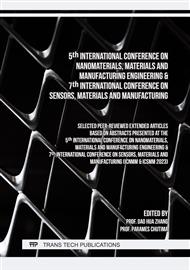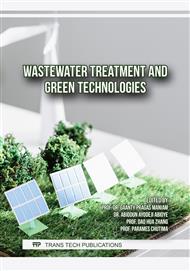[1]
C. Liu, Z.J. Zhang, Chem. Mater. 13 (2001) 2092–2096.
DOI: 10.1021/cm0009470
Google Scholar
[2]
Z. Karimi et al, Mater. Sci. Eng. C 33 (2013) 2465–2475.
DOI: 10.1016/j.msec.2013.01.045
Google Scholar
[3]
I. Sharifi et al., H, J. Magn. Magn. Mater. 324 (2012) 903–915.
DOI: 10.1016/j.jmmm.2011.10.017
Google Scholar
[4]
J.-H. Lee et al., J.-S. Suh. Artificially engineered magnetic nanoparticles for ultra-sensitive molecular imaging. J. Cheon, Nat. Med. 13 (2007) 95–99.).
DOI: 10.1038/nm1467
Google Scholar
[5]
P.Xu et al., Sci. Total Environ. 424 (2012) 1–10. Use of iron oxide nanomaterials in wastewater treatment: a review.
DOI: 10.1016/j.scitotenv.2012.02.023
Google Scholar
[6]
S. Tang et.al., Water Res. 47 (2013) 2613–2632 Review Magnetic nanoparticles: Essential factors for sustainable environmental. applications. https://doi.org/10.1016/j.watres. 2013.02.039.
DOI: 10.1016/j.watres.2013.02.039
Google Scholar
[7]
R. Kaur et al., J. Sep. Sci. 37 (2014) 1805–1825. Synthesis and surface engineering of magnetic nanoparticles for environmental cleanup and pesticide residue analysis: A review.
DOI: 10.1002/jssc.201400256
Google Scholar
[8]
R.D. Ambashta, M. Sillanpää, J. Hazard. Mater. 180 (2010) 38–49. Water purification using magnetic assistance: A review.
DOI: 10.1016/j.jhazmat.2010.04.105
Google Scholar
[9]
C. Liu et al., J. Phys. Chem. B 104 (2000) 1141–1145. Reverse Micelle Synthesis and Characterization of Superparamagnetic MnFe2O4 Spinel Ferrite Nanocrystallites. J. Phys. Chem. B, 2000, 104, p.1141–1145.
DOI: 10.1021/jp993552g
Google Scholar
[10]
D. Kang et al., One-step fabrication and characterization of hierarchical MgFe2O4 microspheres and their application for lead removal, Microporous and Mesoporous Materials (2015).
DOI: 10.1016/j.micromeso.2015.01.023
Google Scholar
[11]
A. Ivanets et al. A comparative study on the synthesis of magnesium ferrite for the adsorption of metal ions: Insights into the essential role of crystallite size and surface hydroxyl groups. Chemical Engineering Journal, Volume 411, 1 May 2021, 128523.
DOI: 10.1016/j.cej.2021.128523
Google Scholar
[12]
Xiaodong Yanga et al., Surface functional groups of carbon-based adsorbents and their roles in the removal of heavy metals from aqueous solutions: A critical review, Chemical Engineering Journal. Volume 366, 15 June 2019, Pages 608-621.
DOI: 10.1016/j.cej.2019.02.119
Google Scholar
[13]
A. Tadjarodi, M. Imani, M. Salehi, RSC Adv. 5 (2015) 56145–56156. ZnFe2O4 nanoparticles and clay encapsulated ZnFe2O4 nanocomposite; synthesis strategy, structural characteristics and adsorption of dye pollutants in water.
DOI: 10.1039/C5RA02163D
Google Scholar
[14]
Diya'uddeen BH et al., (2011) Treatment technologies for petroleum refinery effluents: a review. Process Saf Environ 89:95–105.
DOI: 10.1016/j.psep.2010.11.003
Google Scholar
[15]
R. Kudaibergenova et al. Reduced graphene oxide‑based superhydrophobic magnetic nanomaterial as high selective and recyclable sorbent for oil/organic solvent wastewater treatment International J. of Environmental Science and Technology.
DOI: 10.1007/s13762-021-03722-3
Google Scholar




